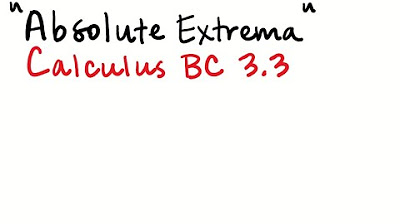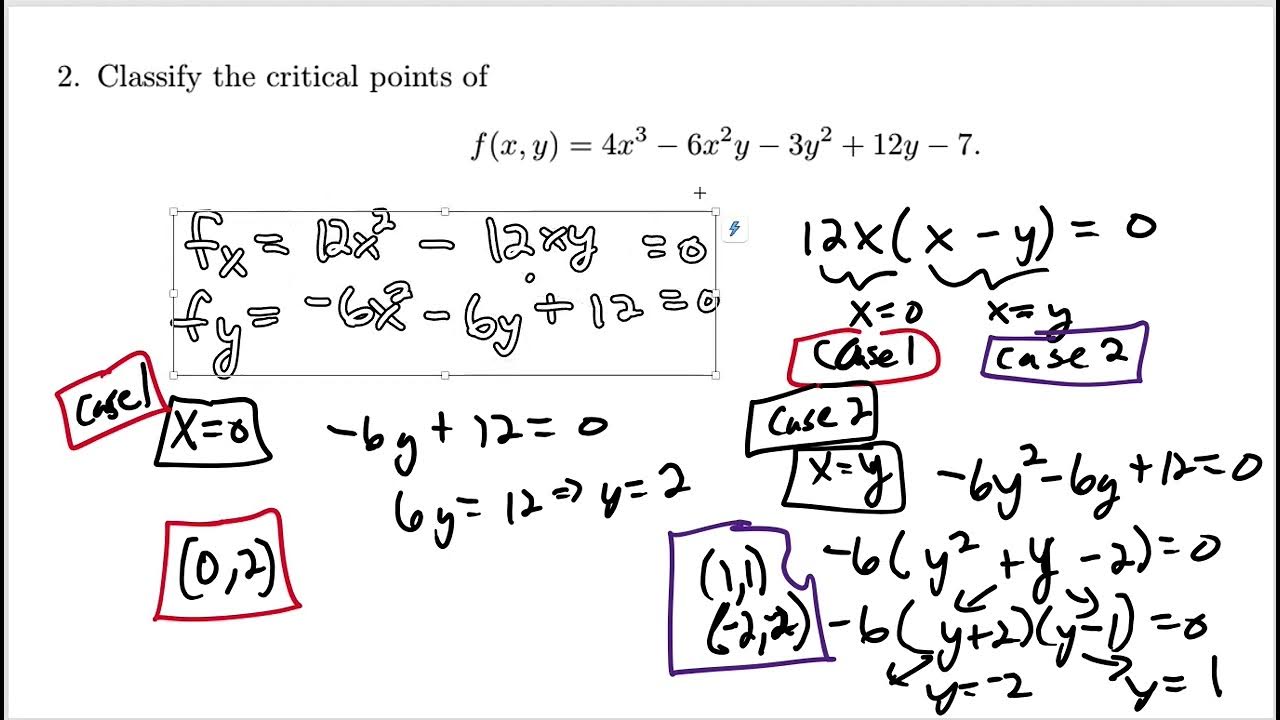Absolute Maximum and Minimum Values of Multivariable Functions - Calculus 3
TLDRThis educational video script offers a step-by-step guide on finding the absolute maximum and minimum values of a multivariable function within a given rectangle. It begins by explaining how to compute partial derivatives with respect to x and y, then sets them to zero to solve for critical points. The script proceeds to illustrate the process of evaluating the function at the rectangle's endpoints and critical points, emphasizing the importance of ensuring the critical point lies within the specified region. By creating a table to compare function values, the video simplifies the identification of the absolute maximum and minimum values, concluding with a clear demonstration of the method's effectiveness.
Takeaways
- 🔍 The video discusses a method to find the absolute maximum and minimum values of a multivariable function on a given rectangle.
- 📝 The first step is to find the partial derivatives of the function with respect to each variable, x and y.
- 🧩 The partial derivative with respect to x involves differentiating each term of the function with respect to x.
- 🔍 The partial derivative with respect to y is found similarly, differentiating each term with respect to y.
- ✂️ Set each partial derivative equal to zero to find potential critical points, solving for x and y.
- 📐 Verify that the critical point lies within the given rectangle to ensure it's a valid candidate for an extreme value.
- 📊 Create a table to systematically evaluate the function at endpoints, critical points, and other points of interest.
- 📈 Analyze each line segment of the rectangle to determine the behavior of the function and identify extreme values.
- 📍 For each segment, substitute the constant variable values into the function to find the range of values the function takes.
- 📉 Recognize that the function's behavior (increasing, decreasing, or constant) on each segment helps in identifying extreme values.
- 🏁 The absolute maximum and minimum values are determined by comparing the function values at all critical points and endpoints.
- 📝 The video concludes by emphasizing the use of a table to easily identify the absolute maximum and minimum values.
Q & A
What is the main topic of the video?
-The video discusses how to find the absolute maximum and minimum values of a multivariable function on a given rectangle.
What are the first steps to find the absolute extreme values of a multivariable function?
-The first steps are to determine the partial derivatives with respect to each variable, in this case, x and y.
How is the partial derivative with respect to x found in the video?
-The partial derivative with respect to x is found by differentiating each term in the function with respect to x and treating y as a constant.
What is the critical point found in the video?
-The critical point found in the video is (2, 2), which is obtained by setting the partial derivatives equal to zero and solving for x and y.
Why is it necessary to check if the critical point lies within the rectangle D?
-It is necessary to ensure that the critical point is within the rectangle D because the absolute extreme values must occur within the given domain of the function.
What is the purpose of breaking the rectangle into four line segments?
-Breaking the rectangle into line segments helps to systematically evaluate the function at endpoints and along the segments to find the absolute maximum and minimum values.
What is the process for evaluating the function on the first line segment (L1)?
-For L1, where y is always zero, the function is simplified to f(x, 0) and evaluated at the endpoints x = 0 and x = 4 to find the minimum and maximum values on this segment.
How is the function evaluated on the second line segment (L2)?
-On L2, where x is always four, the function is simplified to f(4, y) and evaluated at y = 0 and y = 3 to find the maximum and minimum values on this segment.
What is the method used to find the minimum value on the third line segment (L3)?
-On L3, where y is always three, the function is simplified to f(x, 3) and the first derivative with respect to x is set to zero to find the minimum value within the segment.
What is the final step to determine the absolute maximum and minimum values?
-The final step is to compare the function values obtained from the critical point, endpoints, and line segments to identify the absolute maximum and minimum values.
Outlines
📚 Introduction to Finding Extreme Values of Multivariable Functions
This paragraph introduces the topic of finding absolute maximum and minimum values of a multivariable function within a given rectangle. The process begins by calculating the partial derivatives with respect to x and y. The function f(x, y) is provided, and its partial derivatives f_x and f_y are computed. The next step is to set these partial derivatives equal to zero to solve for critical points, which are potential candidates for extreme values. The critical point (2,2) is identified, and it's confirmed to lie within the rectangle D, which is bounded by the points (0,0), (4,0), (4,3), and (0,3). The goal is to determine if this critical point or any other point within the rectangle or on its boundary yields the absolute extreme values of the function.
📐 Analyzing Line Segments for Extreme Values
The paragraph delves into the process of evaluating the function f(x, y) along the boundary of the rectangle D, which is divided into four line segments labeled l1, l2, l3, and l4. For each line segment, the constant variable is identified, and the function is simplified accordingly. The function's behavior (increasing, decreasing, or constant) is analyzed to determine the maximum and minimum values on each segment. For l1, where y is constant at zero, the function simplifies to x^2, with a minimum at x=0 and a maximum at x=4. For l2, where x is constant at four, the function simplifies to a linear decreasing function of y, with a maximum at y=0 and a minimum at y=3. The values at these points are calculated and recorded for comparison.
🔍 Completing the Analysis and Identifying Extreme Values
Continuing from the previous paragraph, the analysis of the remaining line segments l3 and l4 is completed. For l3, where y is constant at three, the function simplifies to a parabolic function of x, with a minimum found at x=3. The function's value at this point is calculated and added to the table. For l4, where x is constant at zero, the function simplifies to a linear increasing function of y, with a minimum at y=0 and a maximum at y=3. However, a mistake is made in the calculation for y=3, which is corrected to 12 instead of 16. The critical point (2,2) is evaluated, yielding a function value of four. The paragraph concludes by identifying the absolute maximum value at the point (4,0) with a value of 16 and the absolute minimum at the origin (0,0) with a value of zero. The use of a table is emphasized for ease of comparison and identification of extreme values.
Mindmap
Keywords
💡Multivariable Function
💡Partial Derivative
💡Critical Point
💡Absolute Extreme
💡Rectangle D
💡Line Segments
💡Endpoints
💡Table
💡Absolute Maximum
💡Absolute Minimum
Highlights
Introduction to finding absolute maximum and minimum values of a multivariable function on a rectangle.
Explanation of determining partial derivatives with respect to x and y.
Derivation of f sub x and f sub y for the given function.
Setting partial derivatives equal to zero to solve for x and y.
Identification of the critical point (2,2).
Visual representation of the rectangle D with endpoints.
Division of the rectangle into four line segments (l1, l2, l3, l4).
Potential locations for absolute extreme values on the rectangle and line segments.
Verification that the critical point lies within rectangle D.
Creation of a table to compare function values at endpoints and critical points.
Analysis of line segment l1 with y constant at zero and function evaluation.
Analysis of line segment l2 with x constant at four and function evaluation.
Analysis of line segment l3 with y constant at three and function evaluation.
Finding the minimum value on line segment l3 by evaluating the derivative.
Analysis of line segment l4 with x constant at zero and function evaluation.
Evaluation of the critical point (2,2) and its function value.
Identification of the absolute maximum value at point (4,0) with a value of 16.
Identification of the absolute minimum value at the origin (0,0) with a value of 0.
Advocacy for using a table to easily identify absolute maximum and minimum values.
Transcripts
Browse More Related Video
5.0 / 5 (0 votes)
Thanks for rating:





